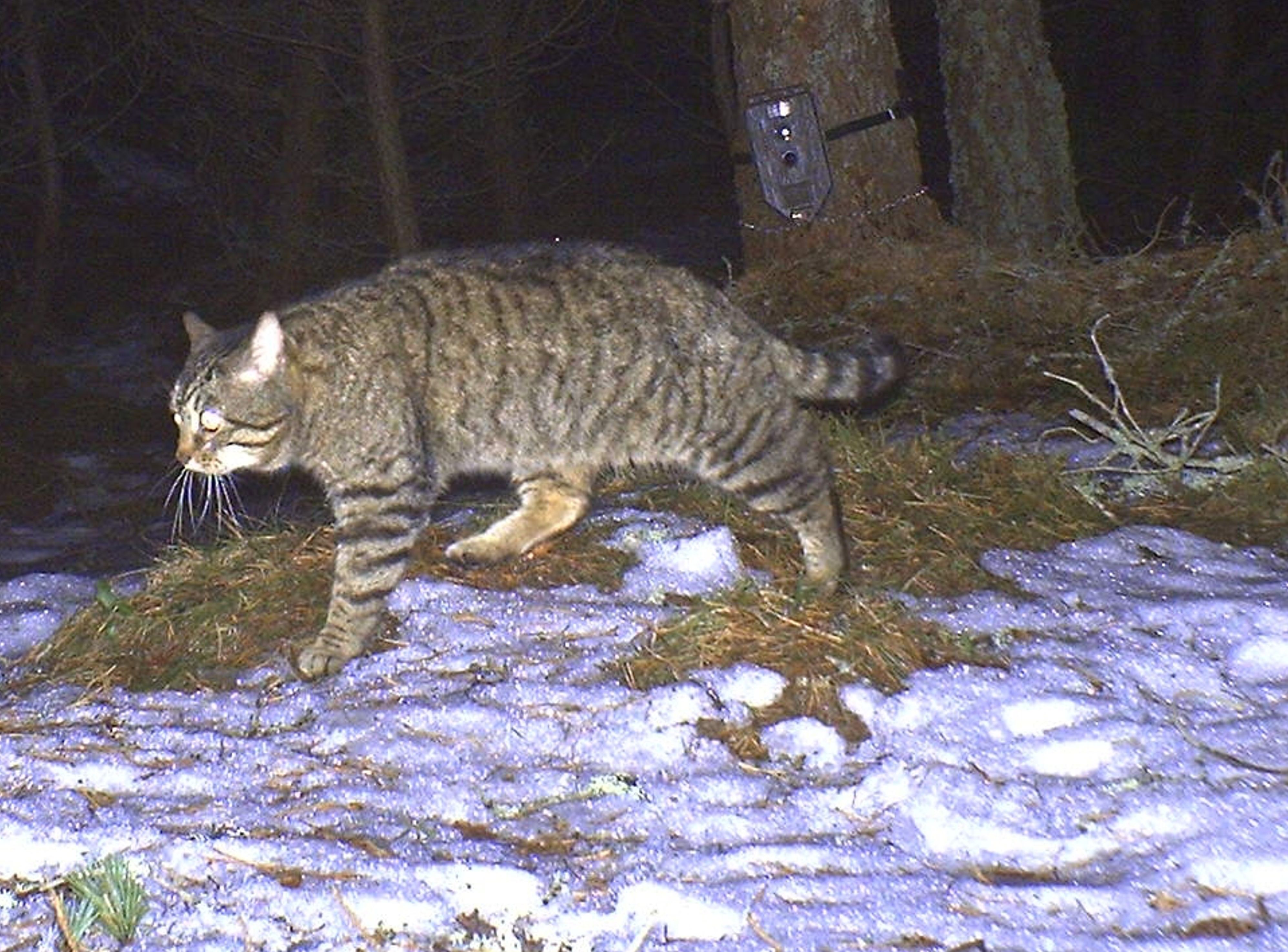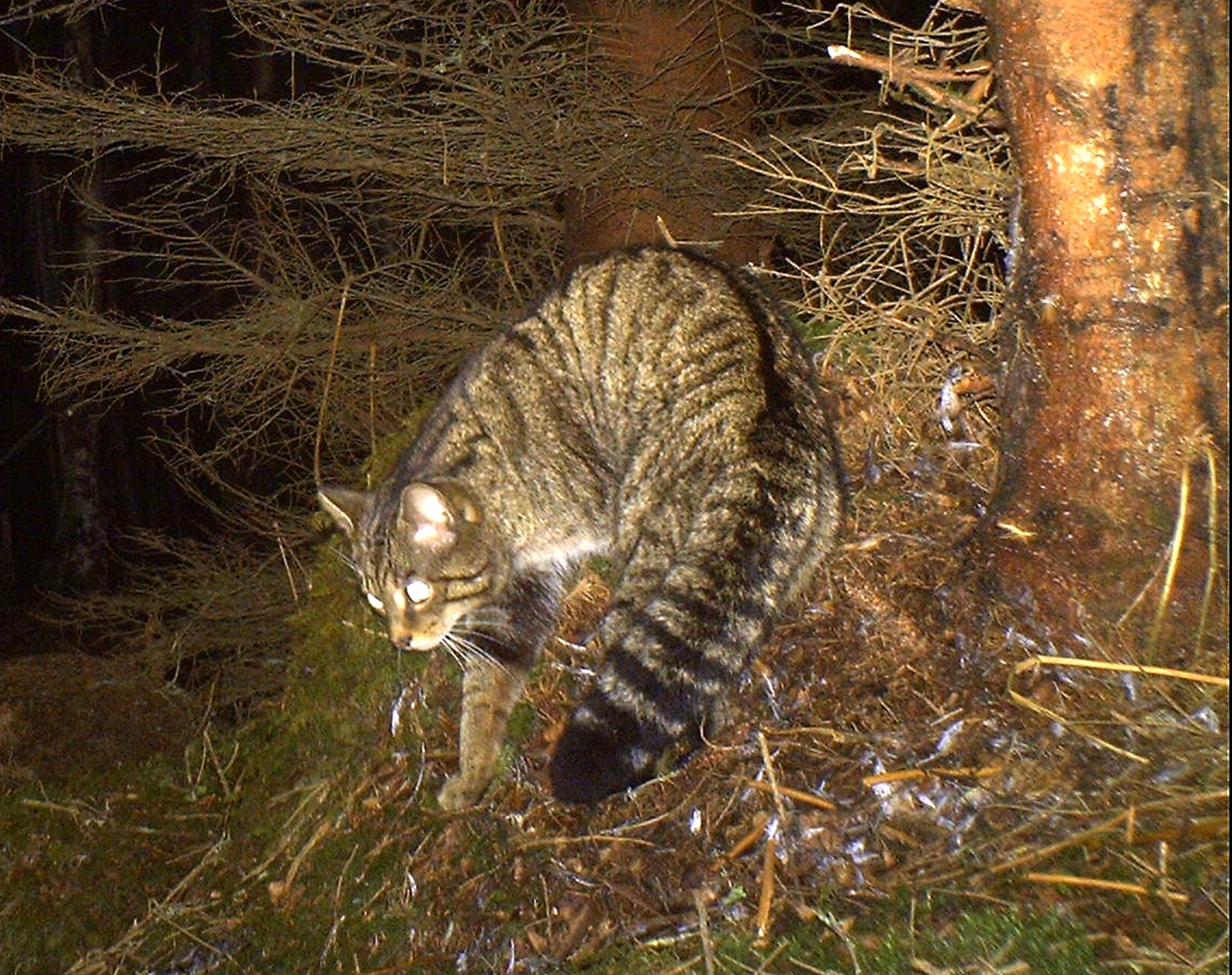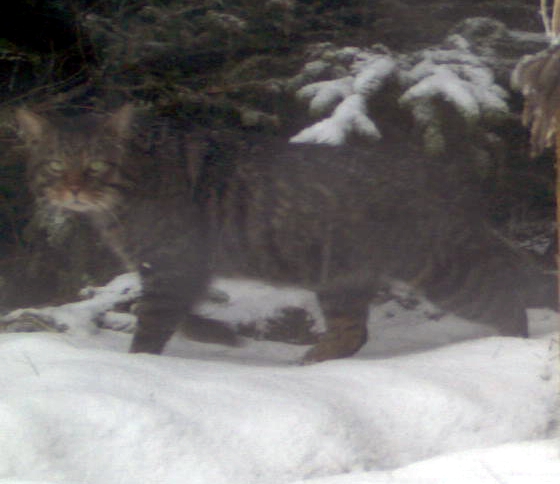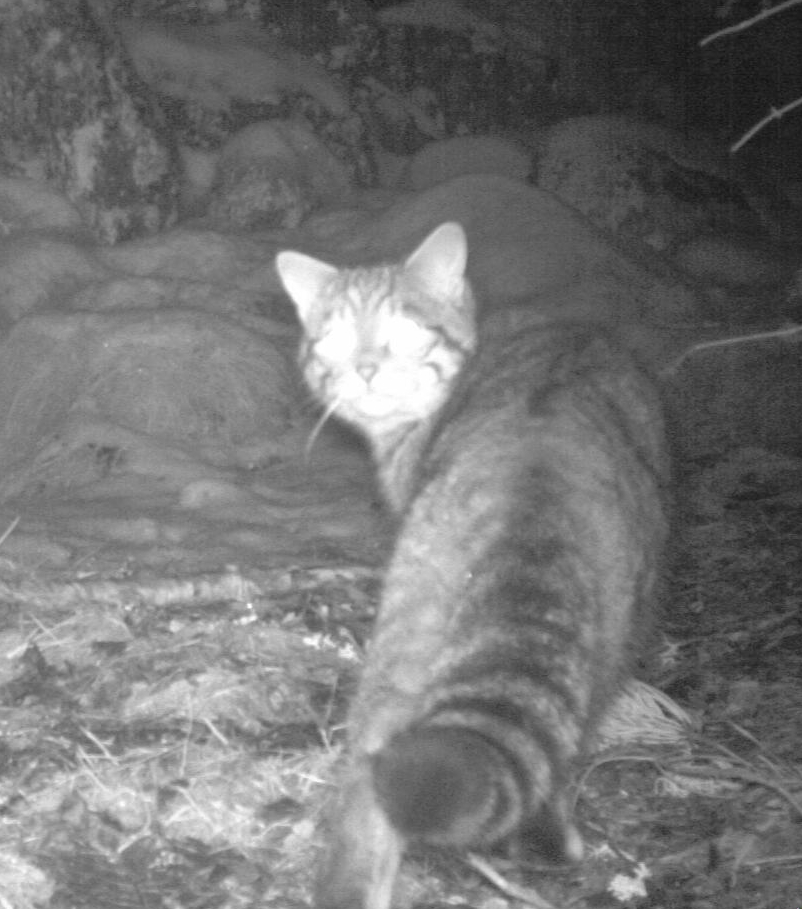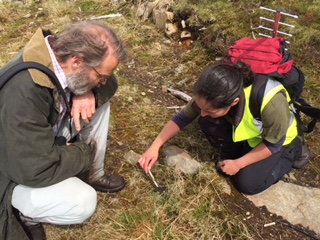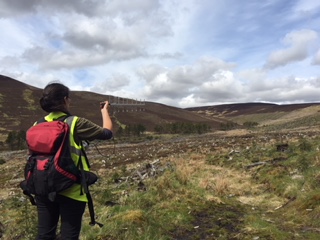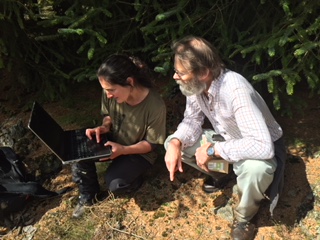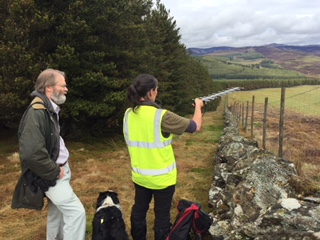Research
Scottish Wildcat Project
WildCRU has been carrying out research on the Scottish wildcat for almost 20 years.
Background
The Scottish wildcat is Britain’s only native felid and once widespread across Britain, the wildcat is now restricted to northern Scotland owing to a variety of factors including habitat loss, persecution and hybridization with the domestic cat. Extensive hybridization with the domestic cat is thought to be one of the main threats facing this species and has resulted in difficulties in distinguishing wildcats from wildcat x domestic cat hybrids and feral tabby domestic cats. The lack of clear cut identification has resulted in problems with collecting ecological data on genetically pure wildcats as well as problems in enforcing conservation legislation, yet the mechanisms of hybridization and extent of introgression are poorly understood. There is a real risk that hybridization will result in the genetic extinction of the Scottish wildcat.
As few as 400 individuals are estimated to remain in the wild, although this estimate was based on extrapolation of the percentage of museum skins that were found to have the wildcat pelage onto another population estimate. As a result, the actual number of wildcats currently remaining is unknown and if fewer than 400 genetically pure individuals are found to remain then the Scottish wildcat would be classified as Critically Endangered. In addition, comparable baseline data on its distribution and densities in different regions of the Scottish highlands, essential for developing practical conservation management plans, is generally lacking for the Scottish wildcat because of the complications associated with hybridization.
Much of WildCRU’s research in the past has focused primarily on how best to identify the Scottish wildcat with detailed research being carried out on ecological behavioural differences (Dr. Mike Daniels), examination of evolution and morphological differences including skull and bone length (Dr. Nobby Yamaguchi) and genetic differences (Dr. Mike Daniels and Dr. Carlos Driscoll). The results of this work led to the production of an Action Plan for conservation of the Scottish wildcat in 2004.
With the development of a pelage identification tool by Dr. Andrew Kitchener at the National Museums Scotland in collaboration with WildCRU and ongoing development in genetics, new methods have evolved allowing more detailed studies to be carried out on distribution and ecology of the Scottish wildcat. This has been aided by recent technological developments in wildlife research including the use of camera trapping which have shown to be more successful than previous methods (road traffic accident surveys, interviews and questionnaires and live trapping) at detecting wildcats in the field. WildCRU’s most recent research has involved the use of extensive camera trap surveys (Dr. Kerry Kilshaw) to look at the current distribution and densities of local wild-living cat population. The widespread camera trap surveys confirmed that hybrids preferred much of the same habitat as wildcats and overlapped in their distribution pattern with both feral domestic cats and wildcats, supporting recent suggestions that the hybridization threat posed by hybrids is exacerbated by their acting as a bridge between wildcats and feral domestic cats. Camera trapping also produced a more updated population size of 167-311 individuals depending on local densities and home range size. Based on these data, the Scottish wildcat should have its current status of Least Concern reviewed. Dr. Roo Campbell has also recently utilised GPS collars to look at the spatial ecology of wild-living cats in northern Scotland (https://www.wildcru.org/research/spatial-ecology-of-the-scottish-wildcat-domestic-cat-and-hybrids/).
In 2013, the Scottish Wildcat Conservation Action Plan (SWCAP) was launched as a concerted national effort led by Scottish Natural Heritage to preserve and expand both the numbers and geographic range of the remaining Scottish wildcats. As a partner in the Action Plan, WildCRU’s current project aims to contribute to our understanding of wildcat ecology and behaviour and how this can affect their conservation management.
Current Project
WildCRU’s current project on the Scottish wildcat is led by Dr. Kerry Kilshaw and looks at the basic ecology of the wildcat and the role GPS collars can play in adaptive conservation management of the Scottish wildcat.
Working closely with the SWCAP, GPS collars will be placed on wildcats in several of the Priority Areas identified by the SWCAP and following objectives are outlined:
Basic Ecology
- Investigate how the spatial ecology of wildcats varies seasonally in order to determine whether wildcats expand their home ranges into previously unidentified suitable habitat (e.g. higher ground over summer, lower ground in winter).
- Determine how wildcats react to adverse weather conditions and what implications this has for management actions (e.g. Campbell (2015) found wild-living cats showed behavioural changes in very wet weather)
- Add to the existing data on home range size and habitat use by individuals in different Priority Areas.
- Identify den sites and the characteristics that could result in their use e.g. cover, prey availability.
Adaptive/Reactive Conservation Management
- Identification of potential hybridization hotspots outside the Priority Areas that could be targeted for Trap Neuter Vaccinate Return.
- Identify potential risks to individual wildcats that could be mitigated through targeted action e.g. reduction of road traffic accidents across regular crossing points through wildlife bridges/tunnels.
- Identification of den sites for monitoring and protection from harmful activities (it is only the den site of the Scottish wildcat which is protected under British and European law, but in the past these have been notoriously difficult to find without using GPS data)
- Use the information collected on habitat use and home range size and movement to assess whether the Priority Areas are large enough to meet the aims of the SWCAP.
- Identify small scale habitat use and activity within different habitats and use this data to map potential wildcat corridors between different wildcat priority areas that could be prioritised for future conservation efforts.
Heatmap of BOGIE’s home range showing primary den site (dark red), secondary den sites/resting places (dark orange), main travel routes (green) and areas with only a few (1-4) gps fixes (dark grey).
Publications on the Scottish wildcat
Daniels, M. J., (1997) The biology and conservation of the wildcat in Scotland, University of Oxford, DPhil Thesis, 207 pp.
Daniels, M. J., D. Balharry, D. Hirst, R. J. Aspinall & A. C. Kitchener (1998) Morphological and pelage characteristics of wild living cats in Scotland: Implications for defining the ‘wildcat’. Journal of Zoology, 244, 231.
Daniels, M. J., Beaumont, M. A., Johnson, P. J., Balharry, D., Macdonald, D. W. & Barratt, E. (2001). Ecology and genetics of wild-living cats in the north-east of Scotland and the implications for the conservation of the wildcat. Journal of Applied Ecology,38,146-161.
Driscoll, C.A. (2011). Genetics and conservation of the Wildcat and Caspian tiger. University of Oxford, DPhil Thesis, 257 pp.
Driscoll, C. A., Menotti-Raymond, M., Roca, A. L., Hupe, K., Johnson, W. E., Geffen, E., Harley, E. H., Delibes, M., Pontier, D., Kitchener, A. C., Yamaguchi, N., O’Brien, S. J. & Macdonald, D. W. (2007) The Near Eastern Origin of Cat Domestication. Science,317, 519-523
Kilshaw, K., Montgomerey, R.A., Campbell, R.D., Hetherington, D.A., Johnson, P.J., Kitchener, A.C., Macdonald, D.W. and Millspaugh, J.J. (2016). Mapping the spatial configuration of hybridization risk for an endangered population of the European wildcat(Felis silvestris silvestris) in Scotland. Mammal Research 61(1), 1-11.
Kilshaw, K. (2015). Introgression and the current status of the Scottish wildcat. DPhil, University of Oxford, pp 232.
Kilshaw, K., Johnson, P.J., Kitchener, A.C. and Macdonald, D.W. (2014) Detecting the elusive Scottish wildcat Felis silvestris silvestris using camera trapping. Oryx 01/2014
Silva, P., Kilshaw, K., Johnson, P.J., Macdonald D.W. and Rosalino, L.M. (2013). Wildcat occurrence in Scotland: food really matters. Diversity and Distributions, 19(2):232–243
Silva, P., Rosalino, L.M., Johnson, P.J., Macdonald D.W., Anderson, N. and K. Kilshaw (2013). Local-level determinants of wildcat occupancy in Northeast Scotland. European Journal of Wildlife Research, 59(3):449-453
Kilshaw, K. (2011). The Scottish Wildcat: Naturally Scottish Series. SNH publication. pp. 58
Kilshaw, K. & Macdonald, D. W. (2011) The use of camera trapping as a method to survey for the Scottish wildcat. Scottish Natural Heritage Report 479.
Kilshaw, K. & Macdonald, D.W. (2010). Reintroduction of the Scottish wildcat into the Scottish highlands; a feasibility study. WildCRU publication, 213 pp.
Kilshaw, K., A. Drake, D. W. Macdonald & A. C. Kitchener, (2009) The Scottish wildcat: a comparison of genetic and pelage characteristics. 67. Scottish Natural Heritage Commissioned Report, pp. 63.
Kilshaw, K., Macdonald, D.W., & Kitchener, A. (2008). Feral cat management in the Cairngorms; Scoping study. Report to Scottish Natural Heritage, No. 22371, 149 pp.
Kitchener, A. C., N. Yamaguchi, J. M. Ward & D. W. Macdonald (2005) – A diagnosis for the Scottish wildcat (Felis silvestris): A tool for conservation action for a critically-endangered felid. Animal Conservation, 8: 223-237.
Macdonald, D.W., Yamaguchi, N., Kitchener, A.C., Daniels, M., Kilshaw, K. & Driscoll, C. (2010). Reversing cryptic extinction: The history, present and future of the Scottish wildcat. In: The Biology and Conservation of Wild Felids (Macdonald, D.W & Loveridge, A. Eds), Oxford University Press.
Macdonald, D.W., Daniels, M.J., Driscoll, C., Kitchener, A. & Yamaguchi, N. (2004) – The Scottish Wildcat: Analyses for Conservation and an Action Plan. Wildlife Conservation Research Unit, University of Oxford, 67 pp
Yamaguchi, N., Driscoll, C. A., Macdonald, D. W., Kitchener, A. C. & Ward, J. M. (2004) Craniological differentiation between European wildcats (Felis silvestris silvestris), African wildcats (F. s. lybica) and Asian wildcats (F. s. ornate): Implications for their evolution and conservation. Biological Journal of the Linnean Society, 83, 47-63
Senn, H., Ghazali, M., Kaden, J., Barclay, D., Harrower, B., Campbell, R. D., Macdonald, D. W., and Kitchener, A. C. 2018 Distinguishing the victim from the threat: SNP-based methods reveal the extent of introgressive hybridisation between wildcats and domestic cats in Scotland and inform future in-situ and ex-situ management options for species restoration. Evolutionary Applications, 10.1111/eva.12720.






